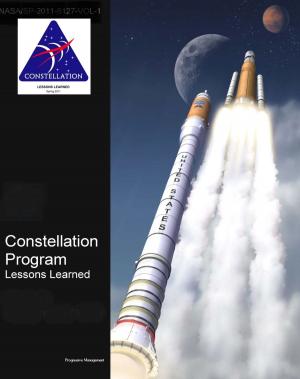Global Positioning System (GPS) Systems Engineering Case Study - Technical Information and Program History of America's NAVSTAR Navigation Satellites
Nonfiction, Science & Nature, Technology, Aeronautics & Astronautics, Science, Physics, Astrophysics & Space Science| Author: | Progressive Management | ISBN: | 9781476324883 |
| Publisher: | Progressive Management | Publication: | July 21, 2012 |
| Imprint: | Smashwords Edition | Language: | English |
| Author: | Progressive Management |
| ISBN: | 9781476324883 |
| Publisher: | Progressive Management |
| Publication: | July 21, 2012 |
| Imprint: | Smashwords Edition |
| Language: | English |
This is one of a series of systems engineering case studies prepared by the Air Force Center for Systems Engineering. This case study analyzes the Global Positioning System (GPS). It is a satellite-based radio navigation system. It provides suitably equipped users the capability to precisely determine three-dimensional position and velocity and time information on a global basis. The capability was developed to provide the United States and DoD with worldwide navigation, position, and timing capabilities to support military operations by enhancing ground, sea, and air warfighting efficiencies. However, by presidential directive, it was officially made available to the civilian community in 1983. GPS also provides the capability to conduct time transfer for synchronization purposes through the use of precise time standards. GPS supports a secondary mission to provide a highly survivable military capability to detect, locate, and report nuclear detonations in the Earth's atmosphere and in near-Earth space in real time.
The study provides a wealth of technical information about this vital satellite-based system and its complex history.
The Department of Defense is exponentially increasing the acquisition of joint complex systems that deliver needed capabilities demanded by our warfighter. Systems engineering is the technical and technical management process that focuses explicitly on delivering and sustaining robust, high-quality, affordable solutions. The Air Force leadership has collectively stated the need to mature a sound systems engineering process throughout the Air Force. Gaining an understanding of the past and distilling learning principles that are then shared with others through our formal education and practitioner support are critical to achieving continuous improvement.
Table of Contents * Preface * Foreword * Acknowledgements * Chapter 1. SYSTEMS ENGINEERING PRINCIPLES * 1.1 General Systems Engineering Process * 1.1.1 Introduction * 1.1.2 Case Study * 1.1.3 Framework for Analysis * 1.2 GPS Friedman-Sage Matrix * Chapter 2. SYSTEM DESCRIPTION * 2.1 Mission * 2.2 Features * 2.3 System Design * 2.3.1 Space Vehicle * 2.3.2 User Equipment * 2.3.3 Control Segment * 2.3.4 Nuclear Detection System (NDS) * 2.3.5 "NAVSTAR/GPS" * Chapter 3. GPS PROGRAM EXECUTION * 3.1 Early Programs * 3.2 Establishment of a Joint Program * 3.3 Concept/Validation Phase (Phase I) * 3.3.1 Objectives * 3.3.2 Requirements * 3.3.3 Acquisition Strategy * 3.3.4 Trade Studies * 3.3.5 Risk Mitigation * 3.3.6 System Integration * 3.3.7 Systems Engineering * 3.3.8 DSARC II * 3.4 System Development (Phase II, Block I) * 3.4.1 Objectives * 3.4.2 Systems Engineering (JPO) * 3.4.3 Interface Requirements * 3.4.4 Budgetary Impacts to Functional Baseline * 3.4.5 Rockwell International Systems Engineering * 3.4.6 Atomic Clocks * 3.4.7 Control Segment * 3.4.8 User Equipment * 3.4.9 Design Reviews * 3.4.10 System Integration * 3.4.11 ICWG * 3.5 Production and Deployment (Phase III, Block II/IIA) * 3.5.1 Objective * 3.5.2 Acquisition Strategy * 3.5.3 Nuclear Detection System * 3.5.4 Shuttle Impact to Functional Baseline * 3.5.5 User Equipment (UE) Development Testing Effects * 3.5.6 Control Segment * 3.5.7 Requirements Validation & Verification * 3.6. Replenishment Program Block IIR * 3.6.1 Objective * 3.6.2 Acquisition Strategy * 3.6.3 Requirements * 3.6.4 Critical Design Reviews * 3.6.5 User Equipment * 3.7 Full Operational Capability * Chapter 4. SUMMARY * Chapter 5. QUESTIONS FOR THE STUDENT * Chapter 6. REFERENCES
This is one of a series of systems engineering case studies prepared by the Air Force Center for Systems Engineering. This case study analyzes the Global Positioning System (GPS). It is a satellite-based radio navigation system. It provides suitably equipped users the capability to precisely determine three-dimensional position and velocity and time information on a global basis. The capability was developed to provide the United States and DoD with worldwide navigation, position, and timing capabilities to support military operations by enhancing ground, sea, and air warfighting efficiencies. However, by presidential directive, it was officially made available to the civilian community in 1983. GPS also provides the capability to conduct time transfer for synchronization purposes through the use of precise time standards. GPS supports a secondary mission to provide a highly survivable military capability to detect, locate, and report nuclear detonations in the Earth's atmosphere and in near-Earth space in real time.
The study provides a wealth of technical information about this vital satellite-based system and its complex history.
The Department of Defense is exponentially increasing the acquisition of joint complex systems that deliver needed capabilities demanded by our warfighter. Systems engineering is the technical and technical management process that focuses explicitly on delivering and sustaining robust, high-quality, affordable solutions. The Air Force leadership has collectively stated the need to mature a sound systems engineering process throughout the Air Force. Gaining an understanding of the past and distilling learning principles that are then shared with others through our formal education and practitioner support are critical to achieving continuous improvement.
Table of Contents * Preface * Foreword * Acknowledgements * Chapter 1. SYSTEMS ENGINEERING PRINCIPLES * 1.1 General Systems Engineering Process * 1.1.1 Introduction * 1.1.2 Case Study * 1.1.3 Framework for Analysis * 1.2 GPS Friedman-Sage Matrix * Chapter 2. SYSTEM DESCRIPTION * 2.1 Mission * 2.2 Features * 2.3 System Design * 2.3.1 Space Vehicle * 2.3.2 User Equipment * 2.3.3 Control Segment * 2.3.4 Nuclear Detection System (NDS) * 2.3.5 "NAVSTAR/GPS" * Chapter 3. GPS PROGRAM EXECUTION * 3.1 Early Programs * 3.2 Establishment of a Joint Program * 3.3 Concept/Validation Phase (Phase I) * 3.3.1 Objectives * 3.3.2 Requirements * 3.3.3 Acquisition Strategy * 3.3.4 Trade Studies * 3.3.5 Risk Mitigation * 3.3.6 System Integration * 3.3.7 Systems Engineering * 3.3.8 DSARC II * 3.4 System Development (Phase II, Block I) * 3.4.1 Objectives * 3.4.2 Systems Engineering (JPO) * 3.4.3 Interface Requirements * 3.4.4 Budgetary Impacts to Functional Baseline * 3.4.5 Rockwell International Systems Engineering * 3.4.6 Atomic Clocks * 3.4.7 Control Segment * 3.4.8 User Equipment * 3.4.9 Design Reviews * 3.4.10 System Integration * 3.4.11 ICWG * 3.5 Production and Deployment (Phase III, Block II/IIA) * 3.5.1 Objective * 3.5.2 Acquisition Strategy * 3.5.3 Nuclear Detection System * 3.5.4 Shuttle Impact to Functional Baseline * 3.5.5 User Equipment (UE) Development Testing Effects * 3.5.6 Control Segment * 3.5.7 Requirements Validation & Verification * 3.6. Replenishment Program Block IIR * 3.6.1 Objective * 3.6.2 Acquisition Strategy * 3.6.3 Requirements * 3.6.4 Critical Design Reviews * 3.6.5 User Equipment * 3.7 Full Operational Capability * Chapter 4. SUMMARY * Chapter 5. QUESTIONS FOR THE STUDENT * Chapter 6. REFERENCES















